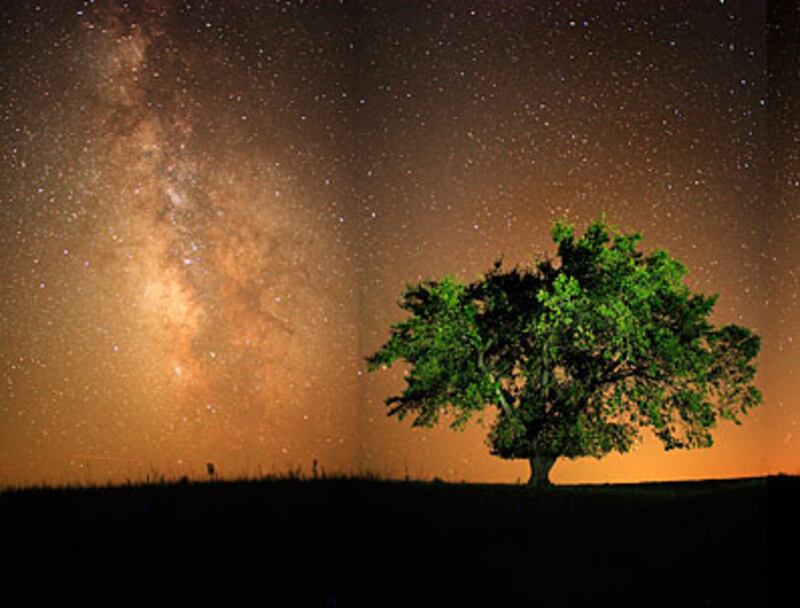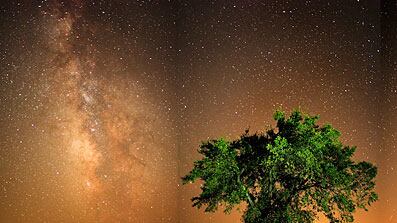Flint Hills, Kansas
The Flint Hills are the world’s largest remaining tract of continuous tall grass prairie, stretching 200 miles north-to-south and 60 miles east-to-west. It is a bittersweet claim-to-fame, considering that tall grass prairie once covered a third of North America. June brings grand events: the rodeo and the Symphony in the Hills. July ushers in natural wonders: six-foot tall blades of Switch, Little Blue Stem, and Big Blue Stem, dotted with purple and indigo wildflowers.
Seeing the grass blow in the wind like a rippling emerald ocean, one questions the wisdom of the pioneers who dubbed the Great Plains the Great American Desert. The Flint Hills are not cool and foreboding like the Sahara or Negev. They’re more like the African savannah, an explosively fertile nurturing cradle. It’s easy to imagine hordes of antelope, elk, and bison running free over these hills the way the giraffes, zebra, and wildebeest lope the Masai Mara.
Rose and Kent Bacon are first-generation ranchers. They grew up as crop and dairy farmers in Iowa, tending corn, soy, alfalfa, hay, oats and clover. When Rose accompanied her father to buy cattle in the Flint Hills as a teenager in the 1960s, she knew one day she would live there. She had never seen so much open space. In Iowa, every inch of land was cultivated—immaculate farms cut into neat squares by two-lane streets.
In 1986, after 25 years of farming, Rose and Kent got serious about finding a Flint Hills ranch after Kent’s doctor told him, “Quit farming or you won’t have any legs left.” A decorated veteran, Kent sustained major injuries when he stepped on a landmine during his tour of duty in Vietnam. He has a prosthetic leg, but that wasn’t the problem. His good leg, the one with the shrapnel in it, was not getting enough circulation. Bending to ride the tractor aggravated the problem. “We had no idea how much his leg would improve from being on horseback,” Rose says.
Their specialty is “backgrounding” young calves, mostly Angus and Herefords. Over the course of two to three months they teach freshly weaned calves how to eat from a bunk and drink from a water trough. It’s a mom-and-pop operation committed to personal attention and humane handling. They take in 300 to 400 calves at a time—though not more than 200 or 300 new ones because they need extra attention—1,200 a year on average. The calves are kept in the corral for three or four days to prevent them from running off; a newly weaned calf will travel a great distance to find his mother. Once the calves learn to eat and drink, they spend their time out to pasture feeding on the calcium rich Flint Hills native tall grass.
Rose and Kent take great pride in the care they give to their calves. Corporate backgrounding farms take in 50,000 calves a year and lose an average of 50 to death. Rose and Kent have lost roughly 18 heads over the course of 20 years, including five to lightning strikes.
In the Flint Hills, the ranchers who manage the land today use it the same way as the indigenous population who lived there before them. There may not be another place outside the U.S. park system that can make that claim. Unlike the national parks where the natural world is preserved by minimal human interference, the Flint Hills in July are the pinnacle of a carefully choreographed annual ritual involving ranchers, cattle, roots, and fire.
Click Image Below to View Jim Richardson’s Photographs of the Kansas Prairie

The roots of Flint Hills prairie grass burrow 12-feet into the earth, which means that fire can clear dead growth, trees, and other foreign species without killing off the grass. Each spring, when the blades are golden and dry as kindling, ranchers set alight the Flint Hills to burn off heavy dead grass and to let the new growth emerge. When the burn is finished, the hills have a brown-green glow of fresh grass peeking from scorched earth.
Lightning started the burns. It was irregular and ferocious. The Kansa Indians observed that when lightning set fire to dry dead grass in the spring, fresh grass grew immediately, drawing hungry buffalo herds, simplifying hunting and providing them with food, shelter, and clothing. They began to burn the prairie deliberately in controlled spaces.
Ranchers learned to burn the prairie from the indigenous population and are just as dependent on this annual practice. After the burn, the hills are blanketed in emerald-green calcium-rich grass. They remain that way for three months, making grazing in the Flint Hills a 90-day experience ending in early August.
During these months, Rose and Kent partner with their horses and dogs to move their cattle slowly and quietly so the cattle don’t get overwhelmed. They know that humane handling makes for a better experience for the cattle and better tasting meat. When an animal becomes excited or frightened, it experiences a rush of adrenaline. This changes the animal’s hormone and acid levels and alters the quality of its meat’s color, texture and taste.
While she’s out in the fields, Rose often has a smoky six-pound brisket braising in the oven. The brisket is a reminder of Kansas’ connections to Texas. It was once common practice for cowboys from Texas to drive their herds to the Flint Hills and finish the cattle on the region’s meadows, before loading the herds onto boxcars on the Santa Fe Railroad to be shipped to markets in the East.
The Santa Fe lined stopped in the heart of the Flint Hills in a town called Cottonwood Falls, a pristine two-block municipality, which looks like it was lifted from a John Ford western. Today Cottonwood falls is home to the Grand Central Hotel, a historic inn built in 1884 with comfortable rooms and what may be Kansas’s best steakhouse, as well as the Chase County Courthouse, a four-story structure built in the Second Empire style with a mansard roof and a clock tower. The Emma Chase Café is cattycorner to the courthouse. On summer nights the café often hosts live music outdoors.
The tall grass prairie is a resilient and tough ecology, but also a fragile one. Once destroyed, developed or changed, it is almost impossible to replace. Even in the Flint Hills, it faces serious threats. The three most egregious are invasive species, ranchettes that splinter the prairie with fences, and wind farms that fragment the prairie with towers anchored 30 feet into the ground and new roads for maintenance.
To protect the Flint Hills, Rose and Kent have placed their ranch in the Kansas Land Trust: they have permanently given up the right to sell the land to an oil company or developers, be they residential or commercial. They hope to turn it over to their children one day or to find a young couple that shares their values and have grown up in the agricultural world. For now, handing over the reins to the ranch is a long way off. The simple act of sharing Rose’s Smoky Flint Hills Brisket under the stars among fireflies and wild alfalfa on a warm July night is as close as Rose and Kent come to the experience of heaven on earth.
Other stories in the summer food series: A Burgundy Wine Feast A Dinner Under the Midnight Sun
Flint Hills Brisket
Smoked paprika and chipotle chiles yield an intensely flavorful rendition of the grand Kansas-Texas BBQ tradition in this first recipe. Rose doesn’t believe in adding too much seasoning when working with prime meat. Her classic brisket calls for an overnight marinade in liquid smoke, Worcestershire sauce and Lawry’s seasoned salt. Serve either dish with asparagus or a green salad tossed with plenty of Roquefort or blue cheese.
Spicy Smokey Flint Hills Brisket
For the rub:
1/4 cup Smoked sweet paprika 1 tbsp. Brown sugar 1 tsp. Cayenne pepper 1 tbsp. Salt 1/2 tbsp. Black pepper, ground
For the braising liquid:
1 tbsp. Canola oil 1 Yellow onion, finely diced 4 cloves Garlic, minced 1/2 cup Celery, finely diced 1 tbsp. Dried mustard 4 Chipotle chiles in adobo sauce, minced 28 oz. Crushed tomatoes 12 oz. Lager or amber beer 3/4 cup Apple cider vinegar 2 Bay leaves 4 cups Water 1/4 tsp. Tabasco
Combine all the ingredients for the rub in a mixing bowl. Place the brisket on a piece of plastic wrap on a sheet tray. Scatter half the rub over the surface of the meat and then use your fingers to distribute the rub evenly. Turn the brisket over and repeat. Wrap the brisket in the plastic wrap and refrigerate overnight.
Place a rack in the center of the oven and preheat the oven to 250°F.
Heat the canola oil over medium heat in a large saucepan until it glistens. Add the onion, garlic and celery. Sauté until the celery is soft and the onion is translucent, about four to five minutes. Add the dried mustard and chipotle chiles. Continue to sauté for another minute, stirring occasionally, before adding the remaining ingredients. Bring the mixture to a boil, then reduce the heat and let the braising liquid simmer for 15 minutes, stirring occasionally. Remove the saucepan from heat and let it cool for 30 minutes.
Meanwhile, remove the brisket from the refrigerator and discard the plastic covering. Using a preheated grill or a large sauté pan over high heat and 2 tbsp. of canola oil, brown the meat, turning it frequently until you have achieved a nice thick uniform sear, about eight minutes per side.
Lay the brisket in a roasting pan and add the braising liquid. On the stovetop, bring the braising liquid to a boil. Remove the roasting pan from the heat and carefully cover it with a fitted lid or heavy-duty aluminum foil. Place the pan in the oven. Braise the brisket for five to six hours, until the meat is fork tender. Remove the roasting pan from the oven and let the brisket rest for 10 minutes. Use a carving knife to cut the meat against the grain into thin slices. Serve warm in the gravy that accumulated during the long slow braise.
Rose Bacon’s Smokey Flint Hills Brisket
1 bottle Liquid Smoke 3 tbsp. Worcestershire sauce 2 tsp. Lawry’s Seasoned Salt 5-6 lb Brisket, trimmed
Combine the Liquid Smoke, Worcestershire sauce and seasoned salt in a large bowl. Add the brisket and thoroughly coat. Cover with the bowl with tinfoil and refrigerate overnight.
Place a rack in the center of the oven and preheat the oven to 250° F.
Lay the brisket in a roasting pan then add the marinade and all the accumulated juices. Cover the roasting pan with a fitted top or heavy-duty aluminum foil. Place the pan in the oven and braise the brisket for five to six hours, at which point it should be fork tender. Remove the roasting pan from the oven and let the brisket rest for 10 minutes. Use a carving knife to cut the meat against the grain into thin slices. Serve warm in the gravy that accumulated during the long slow braise.
Plus: Check out Hungry Beast, for more news on the latest restaurants, hot chefs, and tasty recipes.
Sophie Helene Menin writes about food and wine, sense of place and the pleasures of the table. Her work has appeared in The New York Times, Departures and Saveur, among other publications. She lives in New York City.






